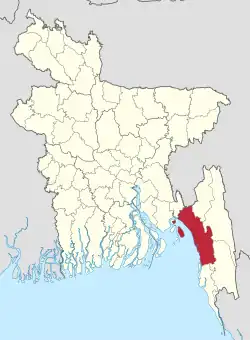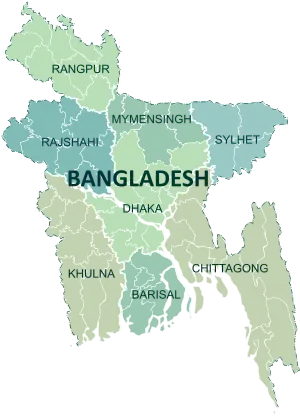Chittagong District
চট্টগ্রাম জেলা | |
|---|---|
| Chattogram District | |
.jpg.webp) .jpg.webp) .jpg.webp)  .jpg.webp) Clockwise from top-left: View of Agrabad, Anderkilla Shahi Jame Mosque, Mahamaya Lake, Port of Chittagong, Chandranath Temple at Sitakunda | |
 | |
Expandable map of Chittagong District | |
| Coordinates: 22°20′15″N 91°50′20″E / 22.3375°N 91.8389°E | |
| Country | |
| Division | Chittagong Division |
| Seat | Chittagong |
| Government | |
| • Divisional Commissioner | Md. Kamrul Hasan |
| • District Council Chairman | Muhammad Abdus Salam |
| • Chief Executive Officer | Khondokar Zohirul Islam |
| Area | |
| • Total | 5,282.92 km2 (2,039.75 sq mi) |
| • Rank | 2 |
| Population (2022 census)[1] | |
| • Total | 9,169,464 |
| • Rank | 2 |
| • Density | 1,700/km2 (4,500/sq mi) |
| Time zone | UTC+06:00 (BST) |
| HDI (2019) | 0.654[2] medium · 3rd of 20 |
| Website | chittagong |
Chittagong District, renamed the Chattogram District,[3] is a district located in the south-eastern region of Bangladesh. It is a part of the Chittagong Division. The port city of Chittagong, which is the second largest city in Bangladesh, is located within this district.
History
Because of the natural harbour, Chittagong had been an important location for trade, drawing Arab traders as early as the 9th century CE. The region fell under the rule of kings from Arakan in the 16th and 17th centuries, but later, the Mughal Army under Shaista Khan conquered Chittagong. During the 17th century, the region also faced a lot of attacks by Portuguese pirates. The Mughals established Chittagong as a district in 1666. Chittagong is the 2nd largest district in Bangladesh by population and area. The Chittagong Hill Tracts were separated from Chittagong in 1860. In 1947, Chittagong came under Pakistan and became part a district of East Pakistan. Port of Chittagong was a big spot for exports and imports of Pakistan. After the liberation of Bangladesh, Cox's Bazar District was separated in 1984.[4]
Administration
Subdivisions
There are 15 upazilas[7] and 31 thanas[8] within Chittagong District. There are 16 Thanas for the Chattogram Metropolitan Police covered area including the Karnaphuli Upazila, 2 for Mirsharai Upazila, and 1 for each of the remaining 13 upazilas.
The upazilas are:
The thanas for the Chattogram Metropolitan Police covered area are:
The thanas for the Mirsharai Upazila are:
- Jorargonj Thana
- Mirsharai Thana
Demographics
| Year | Pop. | ±% p.a. |
|---|---|---|
| 1974 | 3,506,150 | — |
| 1981 | 4,465,158 | +3.51% |
| 1991 | 5,296,127 | +1.72% |
| 2001 | 6,612,140 | +2.24% |
| 2011 | 7,616,352 | +1.42% |
| 2022 | 9,169,464 | +1.70% |
| Sources:[1][10] | ||
According to the 2022 Census of Bangladesh, Chittagong District had 2,143,958 households and a population of 9,169,464, 53.3% of whom lived in urban areas. The population density was 1,736 people per km2. The literacy rate (age 7 and over) was 80.9%, compared to the national average of 74.7%.[1]
Religion
| Religion | Population (1941)[11]: 102–103 | Percentage (1941) | Population (2011)[10] | Percentage (2011) |
|---|---|---|---|---|
| Islam |
1,402,130 | 72.49% | 6,618,657 | 86.90% |
| Hinduism |
470,026 | 24.30% | 861,494 | 11.31% |
| Buddhism |
--- | --- | 121,169 | 1.59% |
| Others [lower-alpha 2] | 62,212 | 3.22% | 15,032 | 0.20% |
| Total Population | 1,934,368 | 100% | 7,616,352 | 100% |
Chittagong is multi-religious. Muslims are in majority with 86.90%, while Hindus and Buddhists are 11.31% and 1.59% respectively. Chittagong has the largest population of Hindus of any district in Bangladesh. Most of the Buddhists are Baruas and their population is decreasing with emigration, while Muslims and Hindus are both increasing in numbers, with Hindus growing more slowly.
Chittagong District has 13,148 mosques, 1025 Hindu temples, 535 Buddhist temples and 192 churches. Fakira Mosque in Hathazari, Musa Khan Mosque, Hafez Para Jame Mosque in Putibila, LOHAGARA, Kura Katni Mosque, Hashimpur Kadam Rasool Mosque in Chandanaish, the 16th century Kala Mosques, Chhuti Khan Mosque, Kadam Mobara Mosque, Andar Killah Mosque, Bakshi Hamid Mosque of Bashkhali, and East Gomdandi Chowdhury Para Old Mosque of Boalkhali are famous mosques in Chittagong. Also Badar Awlia Dargah is a tomb in Chittagong.[12]
The ethnic population is 32,165, consisting mainly of Tripuris and Chakmas.
Language in Chittagong District (1931)[13]
Education
Colleges
- Chittagong College
- Kulgaon City Corporation College
- Gachbaria Government College
- Patiya Government College
- Chittagong Cantonment Public College
- Satbaria Oli Ahmad Bir Bikram College
- Anowara Government College
- Government Hazi Mohammad Mohsin College
- Government City College, Chittagong
- Government College of Commerce, Chittagong
- Chittagong Government Woman's College
- Faujdarhat Cadet College
- Halishahar Cantonment Public School and College
Universities
- Chittagong University
- Chittagong University of Engineering & Technology
- BGC Trust University Bangladesh
- International Islamic University Chittagong
- East Delta University
- Premier University, Chittagong
- Chittagong Veterinary and Animal Sciences University
- Chittagong Medical University
- University of Science and Technology, Chittagong
- University of Creative Technology, Chittagong
- Southern University Bangladesh
Others
- Chittagong Medical College
- BGC Trust Medical College, Chandanaish
- Chittagong Polytechnic Institute
- Chittagong Mohila Polytechnic Institute
Language and culture
The official language of Chittagong is Standard Bengali and the local variety spoken here is known as Chittagonian.[14] It has its own grammar, phonology and vocabulary.
Notable people
- Nurul Abedin[15]
- Oli Ahmad
- Mahbubul Alam
- Mohit Ul Alam
- Ayub Bachchu
- Shyam Sundar Baishnab
- Partha Barua
- Sukomal Barua
- Abdul Karim Sahitya Bisharad
- Abdul Haq Choudhury
- Shantanu Biswas
- Sri Chinmoy
- Pramod Ranjan Choudhury
- Mehazabien Chowdhury
- Rony Chowdhury
- Salahuddin Quader Chowdhury
- Sarat Chandra Das
- Maitreyi Devi
- Charles John Stanley Gough
- Ehsanul Haque
- Enamul Haque
- Enamul Haque
- Chandra Kalindi Roy Henriksen
- Rabiul Hoque
- Somnath Hore
- Ashraful Hossain
- Nazmul Huq
- Tamim Iqbal
- Mamunul Islam
- Nurul Islam
- Mirza Ahmad Ispahani
- Rubayyat Jahan
- Binoy Bashi Joldas
- Abul Kashem Khan
- Akram Khan
- Allauddin Khan
- Dawlat Wazir Bahram Khan
- Morshed Khan
- Dipa Ma
- Anandamayi Ma
- Abdul Mannan
- Suddhananda Mahathero
- Nusrat Faria Mazhar
- Adolph Medlycott
- Minhajul Abedin
- A. B. M. Mohiuddin Chowdhury
- Moniruzzaman
- Anagarika Munindra
- Masuma Rahman Nabila
- Wasfia Nazreen
- Ayub Quadri
- Gulamur Rahman
- Minar Rahman
- Mojibur Rahman
- Mihir Rakshit
- Ramesh Shil
- Tridev Roy
- Bibi Russell
- Iftekhar Sajjad
- Blanaid Salkeld
- Anupam Sen
- Nabinchandra Sen
- Rajat Sen
- Surya Sen
- Jatindra Mohan Sengupta
- Nikhil Baran Sengupta
- Jiban Ghoshal
- Tarakeswar Dastidar
- Ahmed Sharif
- Lokman Khan Sherwani
- L. K. Siddiqi
- Shahidul Yousuf Sohel
- Jack Stephens
- Pritilata Waddedar
- Yasir Ali
- Monica Yunus
- Muhammad Yunus
- Zamor
See also
Notes
- ↑ Sadar subdivision of Chittagong district and Sandwip thana of Noakhali district
- ↑ Including Jainism, Christianity, Buddhism, Zoroastrianism, Judaism, Ad-Dharmis, or not stated
References
- 1 2 3 Population and Housing Census 2022: Preliminary Report. Bangladesh Bureau of Statistics. August 2022. pp. viii, 29, 38, 45. ISBN 978-984-35-2977-0.
- ↑ "Sub-national HDI - Area Database - Global Data Lab". hdi.globaldatalab.org. Retrieved 18 March 2020.
- ↑ Mahadi Al Hasnat (2 April 2018). "Mixed reactions as govt changes English spellings of 5 district names". Dhaka Tribune. Retrieved 8 April 2018.
- ↑ Mohammad Mahibbullah Siddiqi (2012). "Cox's Bazar District". In Sirajul Islam and Ahmed A. Jamal (ed.). Banglapedia: National Encyclopedia of Bangladesh (Second ed.). Asiatic Society of Bangladesh.
- ↑ "AL men appointed administrators". The Daily Star. 16 December 2011.
- ↑ মো. ইলিয়াস হোসেন চট্টগ্রাম বিভাগের শ্রেষ্ঠ জেলা প্রশাসক. Chittagong Pratidin (in Bengali). 27 January 2020. Retrieved 5 July 2020.
- ↑ Jasim Uddin Harun (2012). "Chittagong District". In Sirajul Islam and Ahmed A. Jamal (ed.). Banglapedia: National Encyclopedia of Bangladesh (Second ed.). Asiatic Society of Bangladesh.
- ↑ "Home Minister to launch 4 new thanas in Ctg tomorrow". The Financial Express. 29 May 2013.
- ↑ "Karnaphuli becomes Bangladesh's 490th Upazila". bdnews24.com. 9 May 2016.
- 1 2 3 "Bangladesh Population and Housing Census 2011 Zila Report – Chittagong" (PDF). bbs.gov.bd. Bangladesh Bureau of Statistics.
- ↑ "Census of India, 1941 Volume VI Bengal Province" (PDF).
- ↑ চট্টগ্রামের সবচেয়ে প্রাচীন ইমারত. Prothom Alo (in Bengali). Retrieved 5 July 2020.
- ↑ Census of India 1931
- ↑ Masica, Colin (1991). The Indo-Aryan Languages. Cambridge: Cambridge University Press. p. 16. "The dialect of Chittagong, in southeast Bangladesh, is different enough to be considered a separate language."
- ↑ "Nurul Abedin Profile". ESPNcricinfo.
